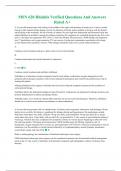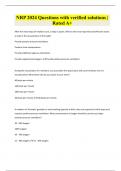MSN 620 Rhinitis Verified Questions And Answers
Rated A+
A 35-year-old man presents with waking in the middle of the night with shortness of breath up to 3 times a month,
having to take frequent breaks during exercise for shortness of breath, and an inability to keep up with his friends
while hiking on the weekends. He has a history of asthma. He uses high-dose budesonide and formoterol daily and
inhaled albuterol as needed to manage his asthma symptoms. His symptoms are controlled during the day if he is not
active. Vital signs are temperature 98 F (36.6 C), heart rate 80 bpm, blood pressure 120/80 mmHg, and respiratory
rate 17 breaths/min, and oxygen saturation 97% on room air. On physical examination, auscultation of his lungs
reveals bilateral late expiratory wheezes. What changes should be made to his current asthma treatment?
A.
Continue current treatment and give a short course of oral corticosteroids.
B.
Continue budesonide and switch formoterol to salmeterol.
C.
C ANS D.
Continue current treatment and add daily zafirlukast.
Zafirlukast is a leukotriene receptor antagonist used to treat asthma. Leukotriene receptor antagonists are the
preferred add-on therapy in patients with exercise-induced bronchospasm and would be the preferred next step in
treating this patient.
Adding zafirlukast to his regimen would alleviate his exercise-induced symptoms and prevent the escalation of
corticosteroid therapy.
Zafirlukast blocks the leukotriene binding of types D4 and E4. Leukotrienes are implicated in allergic reactions and
promote inflammation in asthma and allergic rhinitis.
Zafirlukast takes 2 to 6 weeks for optimal effect and does not reverse acute bronchospasm. Therefore, zafirlukast
should not be used for acute asthma exacerbations or status asthmaticus.
A 56-year-old man presents with a 4-month history of chronic nasal congestion, obstruction, and discharge. He has
had no fevers or chills. His history is significant for allergic rhinitis and hypertension. His medications include
fluticasone nasal spray once daily, cetirizine 10 mg once daily, and montelukast 10 mg once daily. He is using a
nasal saline rinse up to 3 times daily with no relief. He was prescribed a 21-day course of amoxicillin/clavulanate 4
weeks ago, which he has since completed. His symptoms continue to worsen and are beginning to affect his work
life and sleep quality. Vital signs are blood pressure 140/90 mmHg, heart rate 90 bpm, respiratory rate 16
breaths/min, oxygen saturation 95% on room air, and temperature 97.8°F (36.6°C). Physical examination reveals no
tenderness over the maxillary or frontal sinuses bilaterally, no lymphadenopathy, normal tympanic membranes,
normal heart sounds, and clear ANS D.
Refer to otolaryngology for consideration of functional endoscopic sinus surgery.
FESS (functional endoscopic sinus surgery) can be considered in patients who fail maximal medical management
(such as the 21+ day course of antibiotics with persistent symptoms and radiographic evidence of chronic sinus
disease).
,Oral steroids are not routinely indicated in the treatment of chronic rhinosinusitis without nasal polyposis.
There is no consensus on the routine use of prolonged antibiotics to treat chronic rhinosinusitis.
As this patient has failed an appropriate antibiotic regimen for chronic sinusitis, adding a 5-day course would not be
appropriate.
A 30-year-old commercial pilot presents to the clinic reporting symptoms of bilateral otalgia, particularly during
flight ascent and descent. This is associated with 'popping' noises in the ear. He is otherwise normal, although he
occasionally takes antihistamines due to hay fever during summer. Which of the following is the best initial step in
the management of this patient?
A.
Myringotomy with tube placement
B.
Amoxicillin for ten days
C.
Regular antihistamines
D.
Auto-insufflation and topical nasal corticosteroids, with or without oral steroids ANS .
Auto-insufflation and topical nasal corticosteroids, with or without oral steroids
The Eustachian tube, also called the pharyngotympanic or auditory tube, is a vital structure in regulating middle ear
homeostasis, with complex anatomy designed to achieve this function.
Oxymetazoline hydrochloride is helpful with eustachian tube dysfunction in the short term, but this agent should not
be used for longer than five days because of the risk of rebound nasal congestion.
Auto-insufflation, decongestants, and topical and oral corticosteroids can be used for the conservative treatment of
Eustachian tube dysfunction.
Antihistamines alone would have little effect on the Eustachian tube, especially in the absence of significant allergic
rhinitis. Myringotomy with tube placement is reserved for refractory treatment of eustachian tube dysfunction.
Antibiotics play no role in the treatment of eustachian tube dysfunction.
A 17-year-old girl has had a cough associated with exercise for 4 months. She started an exercise program 4 months
ago as part of a weight loss program. Exercise includes walking on a treadmill at the fitness center. She has seasonal
allergies with current rhinorrhea and sometimes has a cough at night, for which she takes diphenhydramine. Past
medical history includes allergic rhinitis and gastroesophageal reflux disorder. Medications include as-needed
famotidine and diphenhydramine. She occasionally has white sputum. Her vitals are normal, and her body mass
index (BMI) is 35.6 m². Exam shows mildly erythematous nasal turbinates and pharynx. The lungs are clear. What is
the next best step to elucidate the cause of her cough?
A.
, Chest radiograph
B.
Spirometry before and after bronchodilator use
C.
Serum IgE
D.
Trial of antihistamine ANS B.
Spirometry before and after bronchodilator use
This patient with a history of allergies and new onset of cough after starting an exercise program likely has asthma
and/or a nasal cause of her cough, including allergic rhinitis, exercise-induced rhinosinusitis, or upper airway cough
syndrome versus exercise-induced bronchoconstriction (EIB). Cough that occurs at night is more indicative of
asthma, allergic rhinitis, or gastroesophageal reflux disorder. The environment in which she is exercising and the
type of exercise, walking, which is less likely to induce the large increase in ventilation that is the root cause of EIB
in susceptible individuals, puts her at low risk for EIB. CHEST guidelines recommend the evaluation of cough in
adolescent athletes, including asthma, EIB, respiratory tract infection, upper airway cough syndrome, and
environmental exposures.
Spirometry before and after the use of bronchodilators can help to confirm the diagnosis of asthma. Up to 90% of
people with asthma experience Exercise-induced bronchoconstriction (EIB). Exercise testing with spirometry,
specifically changes in FEV1, can be undertaken in the future for a diagnosis of EIB.
The patient likely also has an allergic component to her presentation. Upper respiratory tract infections are also more
common in people with EIB due to inflammatory changes to the lung tissue, including increased mucus production.
To appropriately diagnose and treat this patient, the entire airway from nose to lung must be considered.
A 41-year-old woman presents with a rash that comes and goes for most of her life. The rash worsened over the past
weekend and is associated with intense itch. The itch makes sleeping very difficult. She does not take any medicine
or smoke. She has had 3 sexual partners in the last 6 months and uses condoms for protection. Vital signs are
normal. On physical examination, the neck, antecubital fossa, and wrists have thickened plaques with erythema,
erosions from scratching, and crusting. There is thick purulent drainage from several areas of the rash. Which of the
following is the most likely cause of acute worsening?
A.
Bacterial superinfection
B.
Herpes simplex infection
C.
Tinea corporis
D.
Sezary syndrome ANS A.





